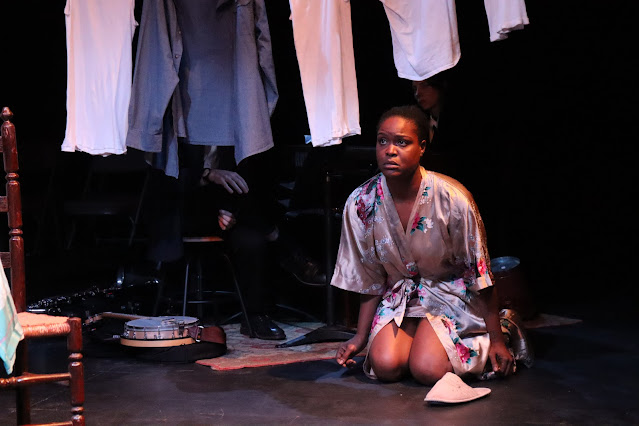Review: In "Pelle," the Beast *Is* Beauty
Pelle/Skin
Written by Chiara Arrigoni
Translated by Giulia Cowie
Mentored by Antoinette La Vecchia
Presented in collaboration with Hystrio Scritture di Scena at Casa Italiana Zerilli-Marimo’ at NYU
24 W 12th St., Manhattan, NYC
May 9, 2025
 |
| Antoinette LaVecchia, Alice Lussiana Parente, Giacoma Bonello, Giulia Cowie, Max Katz. Photo courtesy of In Scena! |
Pelle is part of the third iteration of In Scena!’s translation and adaptation mentorship, presented in collaboration with preeminent Italian theater magazine Hystrio Scritture di Scena. The playwright awarded the mentorship each year travels to New York City to adapt the winning play into an English version in collaboration with a local playwright and a translator–this year, Italian American playwright and actress Antoinette LaVecchia and official translator for the Hystrio Scritture di Scena Mentorship Giulia Cowie, respectively, both of whom also took part in the staged reading of the adaptation. In a pre-show discussion, Arrigoni explained that she took inspiration from a specific fairy tale figure but wanted to keep the family secret that is central to the play ambiguous, giving it wider resonance, and described her desire to explore womanhood as simultaneously monstrous and marvelous. She, LaVecchia, and Cowie also talked about the intensity of the translation and adaptation process, which included several long meetings, the challenges of keeping the feeling and poetry of the original while transposing the play into a more direct American idiom, and the ways in which the adaptation process thrives on multiple perspectives, causing even the playwright to see her original work with new eyes.
The play opens with a prologue listing a wide range of synonyms for skin and verbs for and categories of things that can be done to it, from cleaning to shedding to decorating to burying, before turning to the family on which the play focuses: sisters Anna (Alice Lussiana Parente), Bella (Giacoma Bonello), and Astrid (Giulia Cowie), and their mother (Antoinette LaVecchia). Career-oriented Anna and misfit Bella are, in different ways, lonely, but, after a lively conversation about, appropriately, skin care, Astrid announces that she is getting married to her boyfriend, Him (Max Katz). The general sibling reaction to this announcement can be summed up in Bella's contemptuous anger when Astrid introduces marriage into a storytelling game the sisters are playing with their mother, one family tradition if not the most consequential of them. Interspersed with scenes of Astrid and Him wrangling over guest lists and Him getting blindfolded and blind drunk at his bachelor party (a scene hilariously performed by Katz) are scenes in which the sisters' mother contemplates what sort of eulogy she wants and whether she wants to be visible at her own funeral, along with expressions of wishes by the sisters to, for example, grow fur and thorns or to enter (or return to) a state monstrous and beautiful, wild and free. Running through all of this is the question of whether to let Him in on the family's secret, passed down through its women and kept by each woman in a trunk; and the play's climax–unsparing in the moment and compassionate in its aftermath–sees Him taking on what might be seen as the woman's place in a Bluebeard tale.
In Bella's and Anna's displays of alienation–one telephones random strangers; one rewrites and rewrites her Tinder bio–in their suspicion of Astrid's decision to wed, in all three sisters' desire to live authentically, and in their mother's reflections on her mortality, the idea of "skin" assumes diverse forms and valences. A wedding dress is one kind of signifying skin, one's appearance laid out in a coffin another, as are one's self-presentation at work or on a dating app or in a romantic relationship; even the human body itself is imagined as a kind of shell or rind. Any symbolism is firmly anchored in the realism of the sometimes turbulent bonds of familial and sexual love, expressed by well drawn, nuanced characters rendered even more vivid by the talent of the cast of the staged reading. Given the rich, memorable world conjured by the reading, the next time we encounter Pelle, we hope that it is wearing the skin of a full New York production.
-John R. Ziegler and Leah Richards
More from In Scena! 2025
News: In Scena! Italian Theater Festival NY Announces Venues and Performance Schedule for 2025 Festival
Review: "Alfredino" Taps into an Emotional Wellspring
Review: "In the Name of Mary" Sees Love Cut Short
Review: One Migrant Undergoes a Sea Change in "Lampedusa Beach"
Review: "The Popess" Looks Back to Spotlight Forward-Looking Women



Comments
Post a Comment